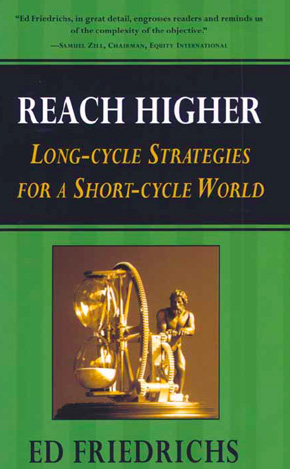
Ed Friedrichs
Atlanta: Ostberg, 2006
While he was Gensler’s CEO, Ed Friedrichs wrote a monthly column in the firm’s employee newsletter that set out what he considered to be the fundamentals of a successful design practice. The general nature of this ambition paved the way for Reach Higher, which is based on that running tutorial, although with a lot of an added material. Reviewing it as an insider (I work for Gensler, but the opinions here are my own), I was curious if he really captured Gensler’s essence. I also wondered if this elixir—at $39 a pop—is something that other firms should consume.
Taken from Gensler’s playbook
The heart of Reach Higher is Friedrichs’ discussion of the attributes that made Gensler so successful—and Attribute #1 is to recognize that time can work for or against you. Every business, design included, has natural cycles that you ignore at your peril. Take leadership transition, that bugbear of architecture firms. You have to start to think about it almost from the beginning to attract the next generation of leaders, keep them engaged, and then pass the torch to them without torching the firm.
Gensler got this one spectacularly right. An ESOP made everyone a shareholder while steadily buying out the founders. The resulting sense of ownership was reinforced from top to bottom by policies that compensated people fairly, even in lean times, and that invited valued employees who chose to leave to “boomerang back whenever you want.”
Listening to the market is another attribute that Friedrichs emphasizes. Given Gensler’s experience in the recent downturn, he stresses the need to hedge and diversify. He also points to Gensler’s readiness to build profitable new offices and practices around its market opportunities, noting that its long-term growth has been largely organic. For firms that intend to grow, this is an important attribute, and he could have said more about it. It’s not the only way to grow, of course—merger and acquisition is increasingly popular, but it poses challenges, especially of cultural integration, that organic growth sidesteps.
While Friedrichs discusses Gensler’s interest in client relationships, noting its preference for ongoing rather than episodic engagements, he only touches on its most revolutionary implications: that time and space are both valid measures of a client’s potential, and that focusing on these relationships makes it completely natural to push client interaction as far down in the organization as possible, flattening it in ways that encourage individual initiative and support a viral marketing style that pulls work in through many portals.
When to dispense with hierarchy
As Friedrichs notes approvingly, this same attribute facilitates a collaborative workstyle that, at its best, spurs design, process, and delivery innovation. That creativity results from a felicitous pairing of talented leaders with equally talented and influential teams. You need both—leaders and influencers—in an operationally flat mix to produce strong and innovative work at the pace that clients now demand. (That clients are part of the process, and a potent source of its creativity, is another reason for Gensler’s success.)
Every firm has and needs a hierarchy, but has to be able to dispense with it in the course of collaboration, understanding that, to function optimally, the team has to allow room for each person to contribute to a necessarily fluid process. Leaders and managers who fear for their authority in the midst of this fluidity inevitably get in its way; those who are confident in themselves and their teams exert their leadership flexibly and intelligently.
You can find this in Reaching Higher, but it’s implied rather than explicitly stated. Friedrichs left Gensler in 2003, just before BIM came on the scene in a big way. In its integrative aspect, BIM almost requires that design be approached as a team sport, a fluid one like soccer where the roles of individual players naturally overlap. Given a more direct experience with it, he might have gone deeper into the issue of how design firms are organized. As it stands, he points to the importance of having an empowering culture and to the need to cultivate individual empowerment at all levels for the good of the firm.
Friedrichs has done us all a favor by turning his in-house tutorial into an accessible guide to running a design firm as a business. Gensler isn’t the only design firm to figure this out, but others can surely learn from its example. Whether you’re reading it to grow a firm or advance your career, Reach Higher is worth buying. In fact, it will pay for itself.
Reviewer John Parman edits Gensler’s client magazine, Dialogue, and contributes to design publications including LINE and Places.
Originally published 1st quarter 2007 in arcCA 07.1, “Patronage.”





